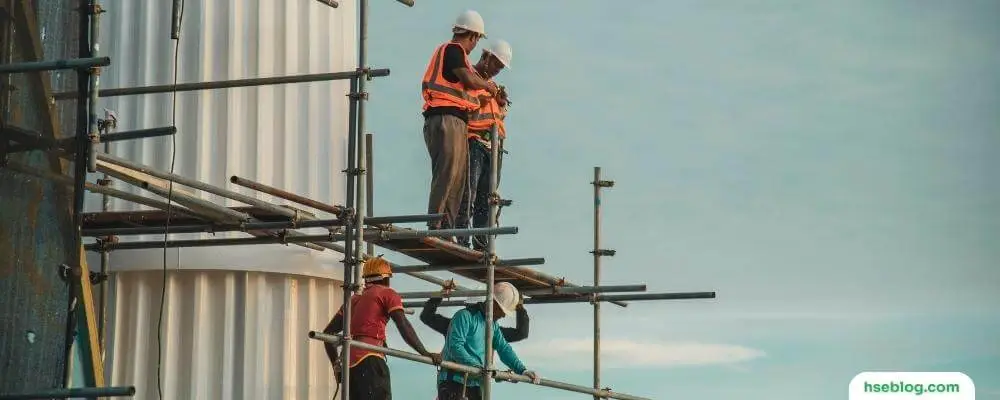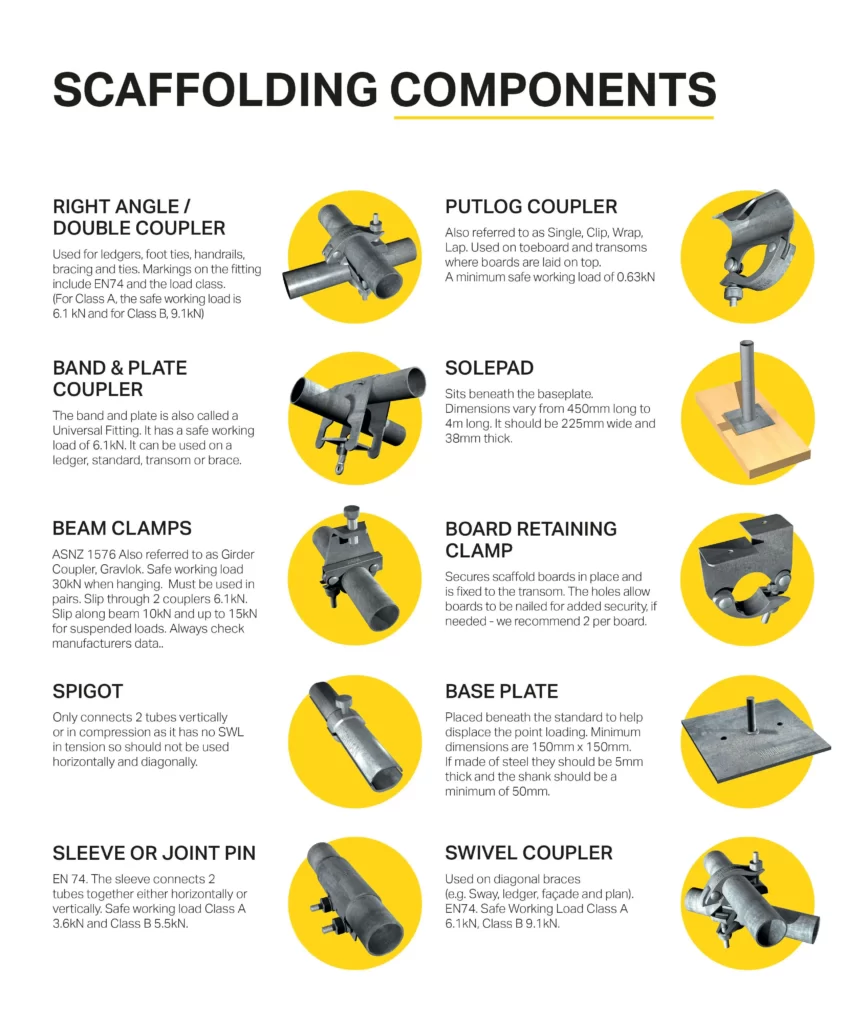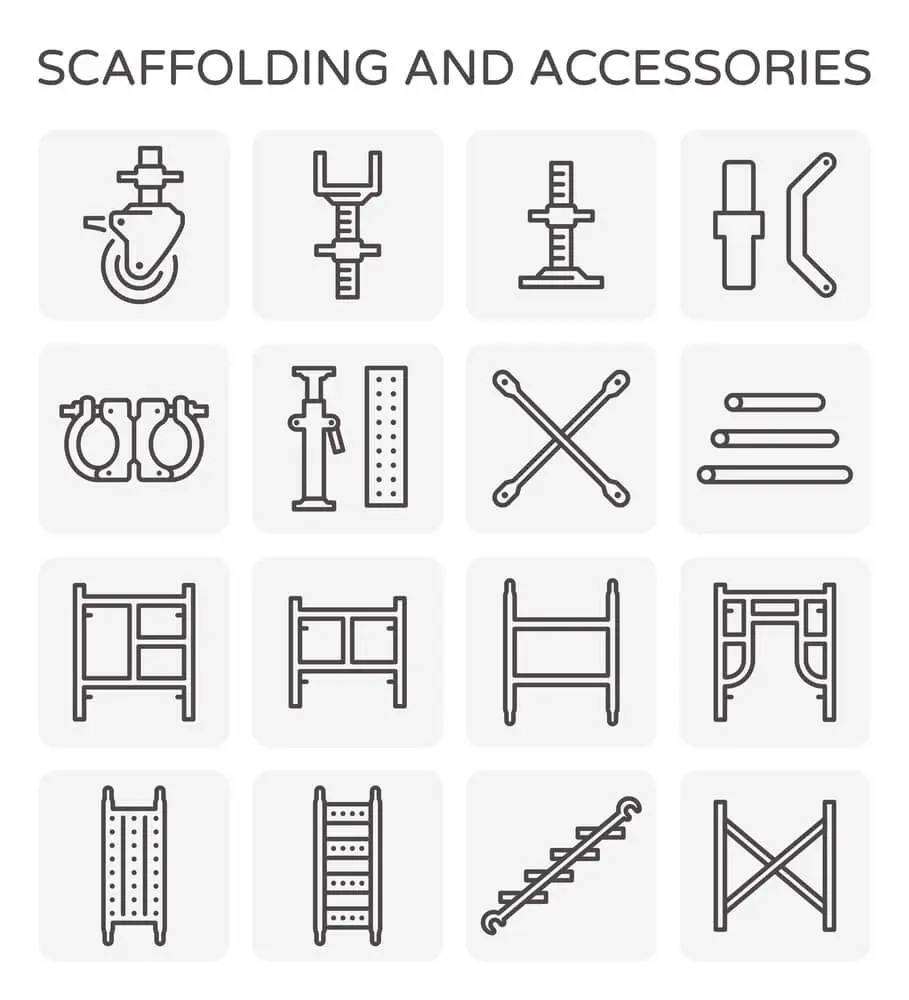Scaffolding is a crucial element in the construction industry, providing workers a secure and elevated working platform. Understanding the various components of a scaffolding system is essential for ensuring safety and stability. This blog will explore the 11 different scaffolding components, including standards, ledgers, transoms, bracing, base plates, sole boards, working platforms, guardrails, toe boards, couplers, and toe boards.
Each component uniquely supports the structure, distributes weight, and provides a safe environment for workers. By delving into the details of these components, professionals and enthusiasts alike can gain valuable insights into the construction and functionality of scaffolding systems, enhancing their understanding of this vital tool in the construction industry.
By comprehending the purpose and function of each scaffolding component, construction professionals can ensure proper installation, maintenance, and adherence to safety protocols. Additionally, individuals interested in scaffolding can gain a deeper appreciation for these components’ intricate design and interplay, fostering a greater understanding of how scaffolding systems are constructed and utilized. Join us on this exploration of scaffolding parts as we uncover the significance of each component and its contribution to the safe and efficient completion of construction projects.

Scaffolding Parts or Components
When it comes to scaffolding parts or components, there are a few key pieces that you need to be aware of. These include ledgers, standards, transoms, braces, and ties. Let’s take a closer look at each one so that you have a better understanding of how they all work together.
1. Standards
Standards are perpendicular tubes that transfer the weight load to the baseplates. Standards are connected using pins and socket joints to increase the scaffolding height. Standards are also used to stabilize the scaffolding and create working platforms.
When working on scaffolding, ensure the standards are properly connected and secured. Also, check the working platform is level and secure before beginning any work. Follow all safety protocols when using scaffolding to avoid accidents.
2. Ledger
Ledgers In Scaffolding are horizontal beams that are used to support the scaffolding. They provide a stable platform for the workers to stand on and work. The ledgers also help to distribute the weight of the scaffolding evenly. Without ledgers, the scaffolding would be unstable and dangerous.
There are two types of the ledger: inside and outside. The inside ledger is attached to the building at one end, and the other is free. The outside ledger is attached to the building at both ends. Ledgers are an essential part of scaffolding and must be used correctly to ensure the safety of the workers.
3. Transoms
Transoms are horizontal tubes spanning ledgers, normally at right angles (90°) to the face of the building. They may also be used to support a working platform. Transoms are an essential part of scaffolding and provide stability and strength to the structure. Without transoms, scaffolding would be unable to support any weight and collapse.
Transoms are generally made of steel or aluminum and are available in various lengths. They are connected to ledgers using clamps or bolts and to each other using couplers. Transoms must be placed regularly along the scaffold length to provide support and stability.
When setting up a scaffold, it is important to ensure the transoms are level and evenly spaced. Otherwise, the scaffold may be unstable and could collapse.
If you use a scaffold for construction or other purposes, ensure it is properly outfitted with transoms. This will ensure the safety of everyone involved and prevent any accidents from occurring.

4. Bracing
One of the most important aspects of scaffolding is its bracing. Bracing helps to keep the structure rigid and stable, preventing it from collapsing or tipping over. Many different types of braces can be used in scaffolding, including diagonal tubes, horizontal members, and cross braces.
When it comes to choosing the right type of braces for your scaffolding, it is important to consider the specific needs of your project. For example, diagonal tubes are often used when the scaffolding is subject to high winds or other potentially hazardous conditions. On the other hand, horizontal members and cross braces are often used in situations where the scaffolding will be supporting heavy loads.
No matter what type of braces you choose for your scaffolding, it is important to ensure they are installed properly. Improperly installed or damaged braces can cause the scaffolding to collapse, leading to serious injuries or even death. If you are unsure how to properly install or inspect scaffolding braces, consulting with a qualified professional is important.
5. Base Plates
Scaffolding base plates are small square metal plates that the standards (uprights) rest on to prevent them from sinking into the ground. Base plates come in various sizes and thicknesses, depending on the load they need to support. Some base plates have holes or slots cut into them to be attached to the scaffolding with nails or bolts. Others have a lip or flange that sits over the top of the standard, providing extra stability.
When selecting base plates for your scaffolding, make sure they are compatible with the type of soil you will be using them on. For example, softer soils may require thicker or larger base plates to provide adequate support. Choosing base plates with the correct load rating for your scaffolding. Base plates are typically rated for light, medium, or heavy loads.
6. Sole Boards
Sole boards are large, flat pieces of timber placed under the base plates of scaffolding to distribute the load over a wide surface area. This is especially important when scaffolding is erected on soft ground, as it prevents the base plates from sinking into the ground and becoming unstable.
Sole boards must be made from strong, durable timber capable of supporting the weight of the scaffolding and any loads that will be placed on it. They should be placed as close together as possible to provide maximum support and securely fastened to the base plates to prevent them from moving or shifting.
Use sole boards to keep your scaffold stable and secure if erecting scaffolding on soft ground.
7. Working Platform
There are two types of working platforms in scaffolding: suspended scaffolds and supported scaffolds.
Suspended scaffolds are platform systems hung from an overhead structure by ropes or cables. They allow workers to access hard-to-reach areas of a building or structure.
Supported scaffolds are platform systems supported by the structure itself rather than being hung from an overhead structure. They are typically used for maintenance and repair work.
Working platforms in scaffolding can be made of wood, metal, or other materials. They must be strong enough to support the weight of the workers and the materials they are working with. The platform must also be stable so it does not sway or wobble.
8. Guardrails
Most scaffolding has guardrails to protect workers from falling off the structure. Guardrails are usually made of metal or wood and are attached to the uprights of the scaffolding. They typically consist of a top rail, a mid rail, and a toe board. Edge protection systems that do not use guardrails are also available.
9. Toeboards
Toeboards are an important safety feature in scaffolding. They are fixed to the standards (uprights) to provide a lip for the platform. This prevents tools and materials from falling off the platform’s edge and protects workers from being struck by falling objects. Toeboards must be at least 4 inches high (measured from the platform’s top) and fitted snugly against the standards so there are no gaps. Toeboards should be secured with wire ties, screws, or other means so they cannot be easily removed.

10. Couplers
Couplers are fittings that hold tubes together in scaffolding. There are three main types of couplers:
- Putlog Coupler: This coupler connects the putlog tube to the ledger tube. It has a flat plate with a hole in the middle for the putlog tube and a lip around the edge to grip the ledger tube.
- Swivel Coupler: This type of coupler connects two tubes at an angle, typically 90 degrees. It has a plate with a hole in the middle for one tube and a pin that goes through the holes in both plates and can be secured with a nut and bolt.
- Right Angle Coupler: This type of coupler connects two tubes at an angle, typically 90 degrees. It has a plate with two holes, one for each tube. The plates are connected with a pin that goes through the holes and can be secured with a nut and bolt.
11. Toe boards
Toe boards are one of the most important safety features of scaffolding. They help to prevent tools and materials from falling off the scaffold and injuring people below. Toe boards also help to keep the work area clean and tidy by preventing debris from falling through the gaps between the scaffold boards.
Several types of toe boards are available, including wooden boards, plastic boards, and metal mesh panels. Wooden toe boards are the most common type of board used on scaffolds. They are easy to install and provide a good barrier against falling objects. However, they can be damaged by water or chemicals, so they must be regularly inspected and replaced if necessary.
Conclusion
Understanding the scaffolding components is crucial for ensuring safety and efficiency in the construction industry. The 11 different components we explored in this blog, including standards, ledgers, transoms, bracing, base plates, sole boards, working platforms, guardrails, toe boards, couplers, and toe boards, all contribute to creating a stable and secure working environment at elevated heights. By comprehending the role and significance of each component, professionals can prioritize safety during scaffolding assembly and maintenance, reducing the risk of accidents and promoting the well-being of workers.
Whether you are a construction professional or simply interested in scaffolding, this knowledge offers valuable insights into the construction process and the intricacies of creating a safe working platform. Adhering to safety protocols, conducting regular inspections, and following industry standards are essential when working with scaffolding. By appreciating the importance of each component, we can strive to elevate safety standards, promote a culture of responsibility, and ensure the smooth progress of construction projects while safeguarding the well-being of workers at all times. Scaffolding continues to play a vital role in the industry, enabling the construction of impressive structures while maintaining a paramount focus on safety.

